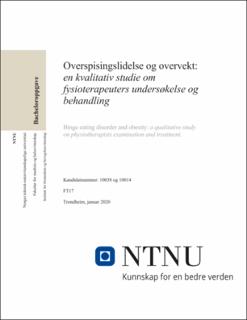| dc.contributor.advisor | Kjeka, Anne Marie | |
| dc.contributor.author | Valstad, Emma | |
| dc.contributor.author | Hetland, Caroline Cecilie | |
| dc.date.accessioned | 2020-06-04T16:02:00Z | |
| dc.date.available | 2020-06-04T16:02:00Z | |
| dc.date.issued | 2020 | |
| dc.identifier.uri | https://hdl.handle.net/11250/2656687 | |
| dc.description.abstract | Bakgrunn: Overspisingslidelse og overvekt er den vanligste spiseforstyrrelsen i dag. Forskning viser at fysioterapeutiske intervensjoner har mange fordeler for fysiske, psykiske og sykdomsrelaterte faktorer hos personer med overspisingslidelse og overvekt.
Formål: Denne oppgaven har som formål å få økt innsikt i hvordan fysioterapeuter undersøker og behandler pasienter med overspisingslidelse og overvekt, samt stille spørsmål ved bakgrunnen for valgt undersøkelse og behandling.
Metode: Kvalitativ metode med semistrukturerte intervju ble valgt som metode. Tre semistrukturerte intervju med fysioterapeuter, som hadde erfaring med pasienter med overspisingslidelse og overvekt ble gjennomført. Datamaterialet ble notert ned, analysert ut fra Malterud (2017) og knyttet mot relevant teori.
Funn: Analysen viser at hovedfokus i undersøkelse er kartlegging av pasientens kroppsbilde og kroppsbevissthet. Vi fant samtidig at en god og tillitsfull relasjon mellom pasient og terapeut vil være avgjørende for behandlingen. Relasjonene som ble dannet mellom pasientene i gruppebehandlingen hadde en positiv og skamreduserende effekt for pasientene. Den individuelle behandlingen ga fysioterapeuten mulighet for individuell tilpasning. Et tverrfaglig samarbeid ga muligheter for ulike behandlingstilnærminger for pasienter med et komplekst sykdomsbilde.
Konklusjon: Vår studie har bidratt til et innblikk i hvordan fysioterapeuter undersøker og behandler pasienter med overspisingslidelse og overvekt, og understreker viktigheten av å øke fysioterapeuters kompetanse i møte med denne pasientgruppen. | |
| dc.description.abstract | Background: Binge eating disorder and obesity is the most common eating disorder today. Research indicates that physiotherapeutic interventions have many benefits related to physical, mental and disease-related factors in people with binge eating disorder and obesity.
Aim: The aim of this study is to gain greater insight into how physiotherapists examine and treat patients with binge eating disorder and obesity, as well as asking questions on the basis of the selected examination and treatment.
Method: Qualitative method with semi-structured interview was selected as method. Three semi-structured interviews with physiotherapists who had experience with patients with binge eating disorder and obesity were conducted. The data was recorded, analysed and linked to relevant theory.
Findings: The analysis shows that the main focus in examination is getting a picture of the patient's body image and body awareness. We found that a good and trustworthy relationship between the patient and the therapist is crucial for the treatment. The relations that were made between the patients in group treatment had a positive and shamereducing effect for the patients. The individual treatment allowed the physiotherapist to individually adapt. Interdisciplinary collaboration provided for different treatment approaches for patients with a complex disease.
Conclusion: Our study have provided new insights in how physiotherapists examine and treat patients with binge eating disorder and obesity. The findings emphasize the importance of increasing physiotherapists competence when meeting these patients. | |
| dc.language | nob | |
| dc.publisher | NTNU | |
| dc.title | Overspisingslidelse og overvekt: en kvalitativ studie om fysioterapeuters undersøkelse og behandling | |
| dc.type | Bachelor thesis | |
